Abstract
During the production of deep oil and gas, scaling, waxing, hydrate ice plugging and other problems easily occur. To solve these problems, reducing the temperature loss of oil pipelines is a feasible method. In order to protect the outer wall coating from being damaged and losing its thermal insulation performance, this paper proposes a developed technology for a novel inner wall coating-insulated oil pipeline. A new temperature-resistant and heat-insulating material aerogel was optimized and developed, and it has an extremely low thermal conductivity of less than 0.055 W/m·K. The influence of different coating processes on the thermal insulation coefficient was analyzed, and a novel inner wall coating-insulated oil pipeline was developed. A testing and evaluation platform for its thermal insulation effect was built, and a finite element model was established to analyze the temperature field distribution. When the thickness of the inner coating was 0.5 mm, the thermal insulation effect of the new oil pipeline improved by about 29%. This technology could be widely used in the production of deep oil and gas, high salinity oil and water reservoirs, thin oil reservoirs, etc., to alleviate scaling and waxing phenomena.
1. Introduction
During the exploitation of high-salinity oil and water reservoirs, heavy oil reservoirs and thin oil reservoirs, etc., the inner walls of oil pipelines are prone to scaling and waxing, resulting in a sharp decline in production. In order to solve the problems of scaling, waxing and hydrate ice plugging, the best way is to increase the temperature of the upper part of oil pipeline. The most convenient way of increasing the temperature of pipeline is to effectively utilize the bottom temperature of wells and reduce temperature loss during fluid production [1,2,3]. Therefore, it is urgent to put forward a new technology of wellbore heat insulation, which not only can effectively reduce heat loss in the wellbore but also has simple surface technology and strong applicability.
Zhang et al. prepared an aerogel insulation blanket by using glass fiber felt and aerogel under normal pressure drying [4]. The insulation blanket can be used as an outer covering part. When the thickness of the insulation layer is 10 mm, its apparent thermal conductivity reaches 0.024 W/m °C. The disadvantage is that the external pressure resistance of the outer covering of the insulation pipe is low, which easily causes external extrusion deformation, resulting in external fluid infiltration into the insulation medium and reducing the insulation effect [5]. The sacrifice of annulus space would lead to jamming when lifting tubing during the well repair process. In addition, in the process of running tubing into the well, it is also necessary to cover the coupling on site, extending working hours.
Xing et al. analyzed and summarized the thermal insulation system and material of pipes, and they found that vacuum thermal insulation pipe was a widely used wellbore thermal insulation technology [6]. The product quality was reliable, and its performance was stable. Compared with the apparent thermal conductivity of traditional insulation pipes, the apparent thermal conductivity was reduced by an order of magnitude. However, after hydrogen permeation failure, the heat flow density of the vacuum-insulated pipe was very large, i.e., more than 10 times of that before the failure, and the heat leakage at the tubing coupling was large, which needed further improvement. Wang et al. established a mathematical model of heat transfer in the insulating layer by testing the apparent thermal conductivity of the insulating oil pipe [7]. The influence of vacuum degree on the performance of vacuum-insulated tubing was analyzed. The main conclusions were as follows: when the internal pressure was 0~20 Pa or greater than 40 Pa, the thermal conductivity increased with the increase in pressure; when the internal pressure was between 20 and 40 Pa, the apparent thermal conductivity decreased with the increase in pressure; when the internal pressure was between 30 and 40 Pa, the apparent thermal conductivity of the insulating oil pipe was small. From a technical and economic point of view, vacuum-insulated pipe is not suitable for deep well operation due to its high price, complex structure and heavy weight.
In addition to the commonly used insulation blanket and vacuum-insulated pipe, many scholars have also carried out studies on thermal insulation coating. Komkov et al. studied the ecological problems of the superheated steam injection method in the process of heavy oil exploitation [8], and they proposed that the most effective thermal insulation material was a highly porous material based on basalt fiber. The cylindrical insulation pipe coating was prepared by filtering and depositing short basalt fiber and alumina. The thickness of the oil pipe was determined according to the thermophysical properties of basalt fiber and the technical characteristics of manufacturing highly porous coating insulation material. During a long period of air extraction at a working temperature of 400 °C, it was found that the surface temperature of the thermal insulation coating did not exceed 60 °C. This technology could greatly reduce the negative impact of heavy oil exploitation on the biosphere.
Lin et al. analyzed three methods of heat transfer in the annulus of heavy oil wells [9], and they proposed a method of combining thermal insulation coating with vacuum technology: the outer wall of thermal insulation tubing is treated with thermal insulation coating; the high-temperature and high-pressure resistant packer is placed at the designated position outside the oil pipeline; the vacuum pump is used to vacuum the oil jacket annulus; and the heat injection operation could be started later. This method can minimize the heat loss of the wellbore and has better heat insulation. The thermal insulation technology combining thermal insulation coating and vacuum technology has the advantages of simple processes, convenient equipment and good thermal insulation, which has good application prospects in offshore heavy oil thermal recovery.
In order to reduce the heat transfer coefficient, diminish heat loss and maintain the temperature of the injected steam, Afra adopted two types of thermal insulators: nanosilicon-based and nanoceramic-based insulators [10]. The results show that when the injection temperature was raised from 119 °C to 145 °C, the heat transfer coefficient increased by about two times, resulting in a rapid decrease in temperature during the injection process. The heat loss of steam injected at 145 °C could be reduced by 45% and 33% using 5 mm thick nanosilicon-based and nanoceramic-based materials, respectively.
The above coatings are all sprayed on the outer walls of oil pipelines. In practical engineering applications, the outer wall coating at oil pipe coupling is easy to damage, losing thermal insulation performance and affecting thermal insulation continuity [5]. The main function of the existing internal coating of pipeline is to prevent corrosion. Therefore, it is urgent to develop a novel inner wall coating-insulated oil pipeline, providing an important guarantee for the extraction of oil and gas in high salinity oil, heavy oil and thin oil reservoirs, etc.
2. Materials and Methods
Due to the limitation of oil well annulus size and wellbore inclination, the outer diameters of heat-insulating oil pipelines is 88.9 mm, and the wall thickness is 6.45 mm. Based on the SY/T 6717-2016 standard, the thickness of inner-wall coating cannot exceed 0.5 mm, so the selected heat-insulating material should have a high thermal insulation performance to reduce temperature drop.
By comparing thermal conductivity of the common materials, such as glass wool, phenolic foam, perlite, aluminum silicate, aerogel, etc., as shown in Figure 1, it is found that aerogel heat-insulating material is not only applicable to a wide range of temperatures but also has the lowest thermal conductivity at different temperatures. Aerogel has good compressive strength, tensile strength, super hydrophobic properties and high fire resistance. Moreover, aerogel material has a super hydrophobicity with the contact angle 160° after special processing and has corrosion resistance properties. Therefore, nanoporous aerogels are the promising choice for the heat-insulating layer for oil pipelines.
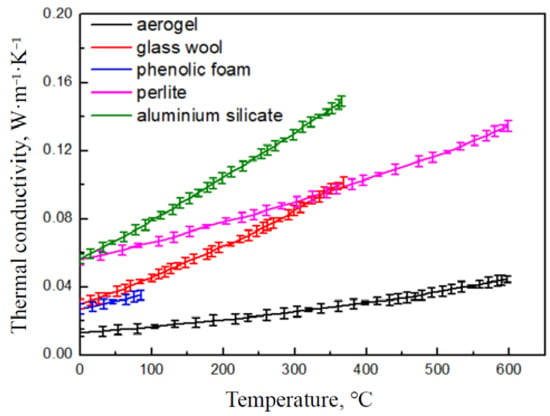
Figure 1.
Thermal conductivity curves of different materials with temperature.
Through nearly 10 years of research and optimization, aerogel heat-insulating material has been successfully applied in petrochemical, marine vehicles, construction and other engineering fields, and has achieved outstanding results. Among them, silica aerogel is considered a promising heat-insulating material because of the nano porous structure (1~100 nm), low density (200 kg/m3), low thermal conductivity (0.013~0.055 W/(m·K), high porosity (80~99.8%) and high specific surface area (200~1000 m2/g) [11,12].
Figure 2 shows the heat-insulating coating model, from which the heat-insulating mechanism of aerogel can be analyzed. The main components of aerogel are resin base, aerogel powder, hollow particles, coating filler, etc. The pore size of aerogel powder is lower than the average free path of air molecules under normal pressure. The air molecules in pores of aerogel are nearly static. The high-strength hollow particles added to the coating components can reduce coating density, improve compressive strength of the coating and reduce the coating damage under the external force. Therefore, the aerogel material could achieve the insulation effect unmatched by other materials [13,14].
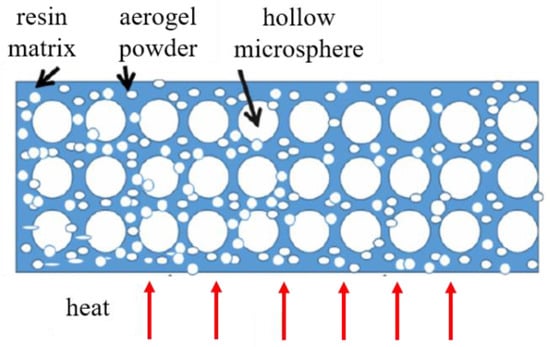
Figure 2.
Heat conduction model of thermal insulation coating.
In this paper, comparative research and analysis are carried out according to the common material classification: inorganic and organic aerogel. The photos of aerogel powder and slurry are shown in Figure 3. The density of the aerogel is 0.5–0.7 g/cm3, and the thermal conductivity is 0.013–0.055 W/(m·K). By adding hollow particles, the thermal conductivity of coating is reduced and the compressive strength is improved.
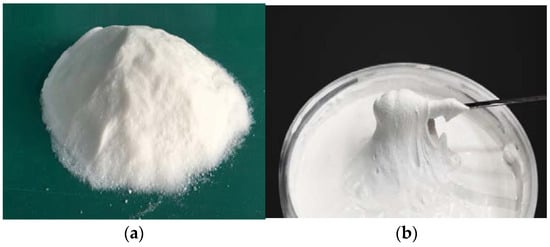
Figure 3.
Schematic diagram of aerogel: (a) powder; (b) slurry.
3. Results and Discussion
3.1. Microstructure and Thermal Conductivity of the Aerogel Material
The microstructures of different materials are studied by SEM. The microscopic images are shown in Figure 4. The organic aerogel is composed of resin, aerogel powder and hollow particles. The hollow particles are spherical with a diameter of about 40 μm. Inorganic aerogel is made of SiO2 aerogel powder and inorganic binder system. A large number of fibrous structures can be seen in the structure, which can increase the compressive and tensile strength of aerogel coating.

Figure 4.
Microstructure of aerogels with different compositions: (a) organic gel-100×; (b) organic gel-200×; (c) inorganic gel-100×; (d) inorganic gel-200×.
Thermal conductivity is measured by using the transient flat plate heat source method based on standard ISO22007-2. The probe of thermal conductivity meter is a power output source and also a temperature detector. The probe outputs a certain amount of power to heat the sample, and the temperature rise of sample is recorded by the probe. According to Fourier diffusion thermal conductivity equation, the power is equal to the thermal conductivity multiplied by temperature rise and divided by distance. Therefore, the thermal conductivity can be calculated. Through the thermal conductivity test of aerogel coating, it is found that the thickness has a greater impact on thermal insulation performance, as shown in Figure 5. With the increase in thickness, the coating temperature decreases, the temperature difference increases and the thermal insulation effect is better. When coating thickness increases from 2 to 4.5 mm, the coating surface temperature reduces from 84 °C to 68.6 °C, the temperature difference increases from 46 °C to 61.4 °C, so the thermal insulation performance can be improved by 33.5%.
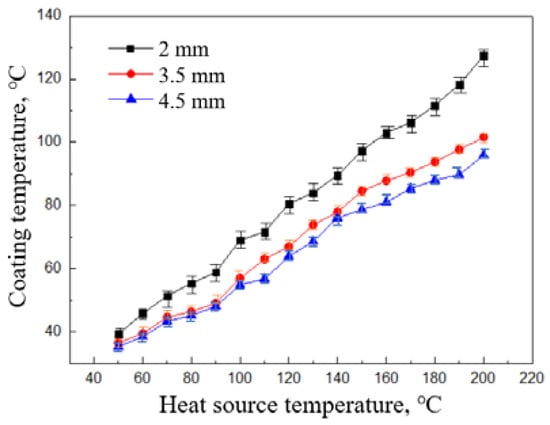
Figure 5.
Temperature variation curve of coating with different thicknesses.
The heat-insulating aerogel is coated on the inner walls of oil pipelines in this paper. The heat-insulating effects of coating thicknesses are studied by spraying or brushing process according to standard SY/T 6717-2016, the achievements can provide a technical support for oil field production.
3.2. Construction of Thermal Conductivity Test Platform
This study proposes a heat-insulating performance test device for inner wall-coated oil pipelines, including heating device, centrifugal pump, heat transfer tubing, circulation pipeline, temperature recorder, etc., as shown in Figure 6. The heating device comprises a temperature controller, an oil bath box, thermal circulating oil, a heating rod, and a thermocouple. The preset temperature of heating rod is set by temperature controller, and heating rod is connected by a thermocouple to monitor the actual oil temperature of oil bath box in real time. The centrifugal pump is connected to oil bath tank through a steel pipe, and the hot oil in oil bath tank is pumped out to circulating pipeline.

Figure 6.
Thermal insulation performance test platform.
The heat insulation oil pipeline is a kind of inner wall-coated one. A new effective heat insulation material, i.e., aerogel is sprayed on inner walls of oil pipes. During spraying construction, the thickness of a single layer coating is 50 μm. When the thickness is sprayed to 200 μm, the next layer of coating is sprayed after the surface drying. The drying method is to dry at 60 °C for 10 h, or dry naturally at room temperature for 48 h. The two ends of circulation pipeline are connected to centrifugal pump and heat insulation oil pipe, respectively. Hot oil circulation inside the oil pipe is formed and a stable temperature value 130 °C is reached. The temperature recorder is connected to insulation oil pipe through thermocouples, and multiple thermocouples can simultaneously monitor the temperature values of the inner and outer walls of oil pipe, forming a temperature–time curve to calculate the thermal insulation of coatings.
3.3. Thermal Conductivity Evaluation of the Insulated Oil Pipelines
The thermal conductivity test platform in Section 3.2 can be used to evaluate the thermal insulation performance of inner wall-coated oil pipelines. The main steps include the following:
Step 1: Use the temperature controller to set the preset temperature of thermal circulating oil at 130 °C (the temperature value is determined according to service condition of oil pipe), heat the thermal circulating oil in oil bath through heating rod and monitor the actual temperature of thermal circulating oil in real time through the thermocouple. When the actual temperature reaches 130 °C, the temperature lasts for 10 min until it is stable.
Step 2: Turn on the centrifugal pump motor, pump the hot oil in the oil bath tank to circulation pipeline and inject the oil into insulating oil pipe to form the hot oil circulation. The hot oil flow rate is 1.2 m3/h, and oil pipe length is 550 mm. When the insulating oil pipe is full of hot oil and the temperature is stable at 130 °C, turn off the heating device and centrifugal pump.
Step 3: The temperature recorder monitors the inner wall temperature value Ti and outer wall temperature value To until the circulating oil in oil pipes is heated to the target temperature value.
Step 4: Wait for the circulating oil temperature in insulated oil pipe to room temperature, and the temperature recorder records series of temperature values that change with time.
Step 5: By comparing the temperature–time curve 1 of internally coated pipe test and the temperature–time curve 2 of pure pipe test, the temperature difference after cooling for a period of time is calculated to determine the thermal insulation performance of inner wall-coated oil pipelines.
The inner wall-coated oil pipelines studied in this paper are divided into organic-aerogel-coated and inorganic-aerogel-coated ones, as shown in Figure 7. Among them, a 0.2 mm-thick organic oil pipe coating is formed by spraying and 0.5 mm thick inorganic coating is formed by brushing due to the existence of fiber. The coating is dried naturally after spraying or brushing, and then hot oil circulation is carried out by welding plugs at both ends of the coated oil pipelines.

Figure 7.
Picture of thermal insulation oil pipe: (a) coating oil pipe; (b) after welding plug.
Figure 8 shows the temperature change curve of coated pipes during the physical temperature rise tests. The temperature–time curves of organic aerogel-coated pipe, inorganic-aerogel-coated pipe and pure pipe are presented in temperature rise processes. The ambient temperature is 20 °C. When the inner walls of pure pipe are heated to 130 °C, the outer wall temperatures of pure pipe, inorganic-aerogel-coated pipe and organic-aerogel-coated pipe are 117.8 °C, 115.5 °C and 113.2 °C, respectively. It is found that the thermal insulation effect of organic-aerogel-coated pipe is the best one. For the coating of greater thickness, 0.5 mm, a three step spraying method can be used, i.e., firstly, a 0.2 mm thick coating is applied; after the surface drying, another 0.2 mm thick coating is applied; and finally, the 0.1 mm thick coating is applied.
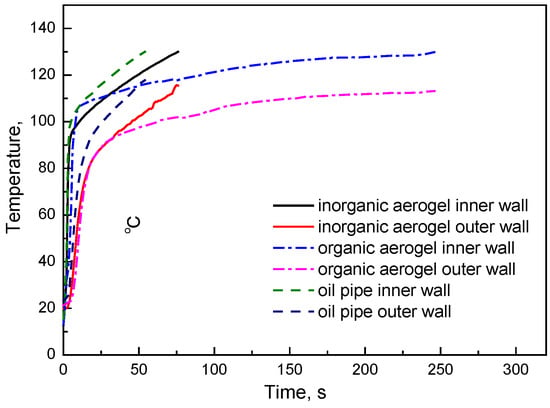
Figure 8.
Temperature curves of oil pipe heating process.
When the thickness of organic aerogel coating is 0.2 mm, the temperature difference between inner and outer walls of pipe is 16.8 °C, which is 38% higher than that of pure pipe. When the thickness of inorganic aerogel coating is 0.5 mm, the temperature difference between inner and outer walls of pipe is 14.5 °C, which is 19% higher than that of pure pipe.
For relatively long oil pipes, there are certain difficulties in the inner wall spraying process. Therefore, in order to systematically study the insulation performance of inner coating insulation oil pipes with different coating thicknesses, the finite element simulation method is adopted, which is validated using existing experimental data and can also intuitively represent the changes of temperature fields. Based on the ABAQUS platform, a finite element model of thermal insulation pipe is established to analyze the temperature change of inner wall-coated pipes. The FEA governing equations include equilibrium equations, geometric equations, and constitutive equations. The equilibrium equation is as follows:
where is the stress component and is the external force.
The geometric equation is as follows:
where is the displacement component and is the strain component.
The constitutive equations are as follows:
where is deviatoric stress tensor; is the equivalent stress, ; and is equivalent strain rate, .
The FEA governing equations for heat transfer problems include Fourier’s heat transfer law and energy conservation law. The transient temperature field of an object is T(x, y, z, t), governing equation is as follows:
where is material density, and the unit is kg/m3; is specific heat of material, and the unit is J/(kg·K); , , are thermal conductivity coefficients along the x, y, and z directions, respectively, and the unit is W/(m·K); is heat source intensity inside the object, and the unit is W/kg; T is temperature; and t is time.
The diameter of oil pipe is 88.9 mm, wall thickness is 6.45 mm and pipe length is 550 mm; hexahedral grids are used, and the number of both grids in the diameter direction of the oil pipe and coating is 5. The minimum grid size of the oil pipe is 1.2 mm, the minimum grid size of the inner-wall coating is 0.04 mm and the number of coating grids is 20,100. The thermal expansion coefficient of the oil pipeline is 1.3 × 10−5 °C−1, and that of the coating is 4.5 × 10−5 °C−1. The environment temperature outside the oil pipe is 20 °C and the inner wall temperature of coating is 130 °. The film coefficient between the oil pipe and the coating is 15 W/(m2·°C). The bottoms of the oil pipes and coating are fixed in the U2 direction. The Von Mises yielding criterion and isotropic hardening law are adopted. Considering the heat transfer between oil pipe and coating, heat transfer (transient) solver is adopted.
As shown in Figure 9, during the process of temperature elevation, the temperature field distribution of the 0.2 mm thick coating of organic aerogel is presented. When the inner wall of pipe reaches 130 °C, there is an obvious temperature gradient from the inner to the outer wall of the pipe. The main parameters of the finite element model can be determined by combining the finite element model with the indoor full-scale test. By adjusting thermal conductivity of the coating material in finite element model, different outer wall temperature values of the pipe can be simulated. When the outer wall temperature value is equal to test temperature 113.2 °C, the thermal conductivity of coating material is 0.052 W·m−1·K−1. Other parameters of the finite element model, including thermal expansion coefficient, elastic modulus and density, are shown in Table 1.

Figure 9.
Temperature distribution graph with the inner wall 130 °C.

Table 1.
Finite element simulation parameters.
Figure 10 shows the temperature change curves of inner-coated pipes during the physical cooling tests. When the temperature in pipes increases to 130 °C, there is a certain temperature difference between the inner and outer walls due to coating, as shown in Figure 10a. The temperature recorder is used to record the series of temperature values that change with time. It is found that the temperature of the inner wall of the oil pipe decreases exponentially with the change of time. When the time is 180 min, the thermal insulation performance of 0.2 mm organic aerogel coating increases by about 10%.
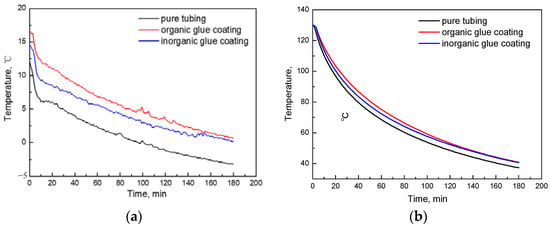
Figure 10.
Temperature change curve of coated tubing: (a) temperature difference between inner and outer walls of pipe at the preset temperature; (b) temperature drop curves of inner walls.
By establishing the finite element model of cooling process, the temperature field change law is presented, as shown in Figure 11. When the inner wall of tubing is heated to 130 °C, the pump is turned off and the coated pipe is cooled naturally that we might study the temperature change law. When the inner wall of pipe is sprayed with 0.2 mm organic aerogel coating, the temperature of inner wall is 102 °C and that of the outer wall is 40 °C after 40 min.
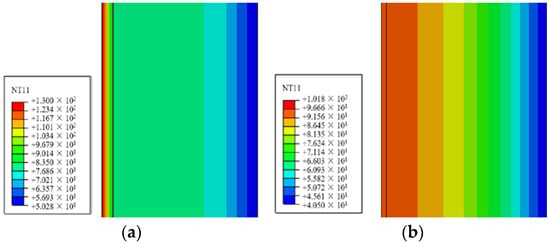
Figure 11.
Temperature change process of pipe with coating thickness 0.2 mm: (a) cooling for 10 min; (b) cooling for 40 min.
Based on the finite element simulation platform, the temperature variation of organic coating with thickness 0.5 mm is studied. When the coating thickness is 0.5 mm and the other finite element model parameters are the same as 0.2 mm, as shown in Figure 12, it is found that when the inner wall temperature of oil pipe is 130 °C and the heating time is 246 s, the outer wall temperature of 0.2 mm-coated oil pipe is 113.2 °C, while the outer wall temperature of the 0.5 mm-coated oil pipe is only 81.7 °C, indicating that thickness has a great impact on the thermal insulation effect of coating. Under the condition that the process is satisfied, the thermal insulation effect of coating could be improved by increasing coating wall thickness as much as possible. This technology may acquire good industrial application.
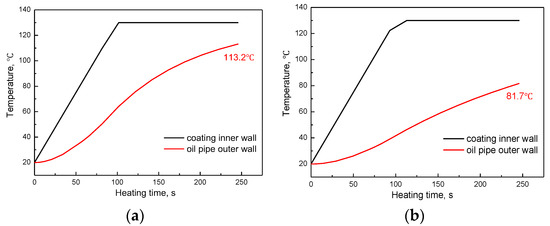
Figure 12.
Temperature rise process of tubing under different coating thickness: (a) 0.2 mm; (b) 0.5 mm.
Comparing the indoor test and numerical simulation data of cooling process of the 0.2 mm-thick coating, as shown in Figure 13a, the temperature drop rate gradually decreases with the increase in time. When the time is 180 min, the difference between test and simulation value is 2.4 °C; the error rate is about 6%, which proves the reliability of the finite element model.
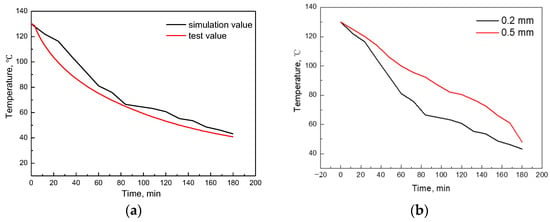
Figure 13.
Cooling process of tubing with different coating thicknesses: (a) simulated value and test value at 0.2 mm; (b) comparison curves of 0.2 mm and 0.5 mm.
Further, a finite element model is established to analyze the cooling law of the inner wall of the coated pipe when the coating thickness is 0.5 mm, as shown in Figure 13b. Compared with 0.2 mm, the temperature drop rate is small. After 180 min, the temperature of pipe inner wall is 48 °C; compared with the 43.2 °C of the 0.2 mm-coated pipe, the temperature is increased by about 5 °C; compared with the 37.3 °C of the uncoated pure pipe, the thermal insulation performance is improved by 29%, which can reduce the temperature loss near the wellhead position and effectively make use of the downhole temperature. The heating and cooling temperature fields of the 0.5 mm-coated oil pipe is shown in Figure 14. The temperature difference of the pipe wall is large between the inside and outside parts, indicating that the thermal insulation performance of aerogel thermal insulation coating is good. Since the inner wall temperature of 0.5 mm inner-coated tubing is 48 °C, which is greater than the scaling and waxing point of most oil fields, the inner coating can effectively prevent the scaling and waxing of oil pipelines.
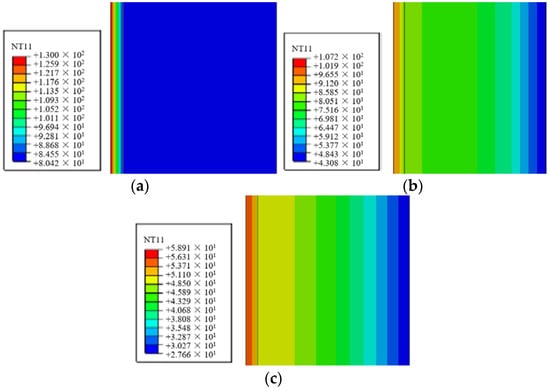
Figure 14.
Temperature change process of tubing with coating thickness 0.5 mm: (a) heating to 130 °C; (b) cooling for 60 min; (c) cooling for 180 min.
To sum up, through the development of new heat-insulating coating materials, new thermal insulation pipe products and the establishment of a test and evaluation platform for the thermal insulation effect, it is determined that the thermal insulation effect of the new thermal insulation pipe has increased by more than 20%, which can thus be widely used in the development of deep oil and gas, high-salinity oil and water wells, thin oil wells, etc., to alleviate the ice blocking, scaling, waxing and other phenomena caused by natural gas hydrate. In our subsequent research, a layer of 50-μm thick corrosion-resistant high-temperature primer was first sprayed on the inner wall of oil pipe; then, the 500 μm thick aerogel thermal insulation coating was sprayed upside the primer layer; finally, a layer of wear-resistant and anti-corrosion topcoat was sprayed. After the topcoat drying, the friction coefficient is small, so the entire insulated tubing has a smooth surface, reducing the surface roughness of oil pipelines. Therefore, the inner-wall coating of the oil pipe could not affect the fluid flow rate, and meanwhile, it has strong corrosion resistance. The downhole temperature could effectively be used to increase the storage and production of group company, as well as to also provide technical support for cost reduction and efficiency increases.
4. Conclusions
To solve the problems of scaling and waxing caused by high temperature loss near the wellhead part during the mining process of high-salinity oil and water, heavy oil and thin oil reservoirs, etc., a novel inner wall coating-insulated oil pipeline for scale and wax prevention is proposed in this paper. A high thermal insulation coating material–organic aerogel for the inner wall of the oil pipeline has been optimized and developed, which has an extremely low thermal conductivity of less than 0.055 W/m·K. The thermal insulation effect increases with increasing coating thickness. Based on the coating densification, the appropriate coating process of the inner-wall coating is determined to be spraying. For the coating thickness of 0.5 mm, a three-step spraying method could be used. Then, an indoor test platform for the thermal insulation performance of inner wall coating-insulated oil pipeline was built, including a heating device, centrifugal pump, heat transfer tubing, circulation pipeline, temperature recorder, etc. A test and evaluation method for the thermal insulation coating material performance is established, and a finite element model is established to analyze the temperature field distribution. In comparing the outer temperature of the inner wall-coated oil pipeline with that of the uncoated oil pipeline, it is found that when the coating thickness is 0.5 mm, the thermal insulation performance is improved by 29%. Since the inner wall temperature of 0.5 mm-coated pipe is 48 °C, which is greater than the scaling and waxing points of most oil fields, the inner-coated oil pipelines can effectively prevent scaling and waxing phenomena.
Author Contributions
Conceptualization, J.C. and J.W.; methodology, J.C.; software, J.C.; validation, W.M., W.H. and Z.S.; formal analysis, Y.Z.; investigation, J.C.; resources, J.W.; data curation, J.C.; writing—original draft preparation, J.C.; writing—review and editing, J.C.; visualization, W.M.; supervision, J.W.; project administration, J.C.; funding acquisition, J.C. All authors have read and agreed to the published version of the manuscript.
Funding
This research was funded by the China National Petroleum Corporation (2021DJ2705, 2021DQ03(2022Z-10), 2020B-4020) and the Study on Key Technologies of Production Increase and Transformation of Gulong Shale Oil (2021ZZ10-04). The APC was funded by the China National Petroleum Corporation (2021DQ03(2022Z-10)).
Data Availability Statement
No new data were created or analyzed in this study. Data sharing is not applicable to this article.
Conflicts of Interest
The authors declare no conflict of interest.
References
- Liang, W.T.; Zhu, L.Q.; Li, W.P.; Yang, X.; Xu, C.; Liu, H.C. Bioinspired composite coating with extreme underwater superoleophobicity and good stability for wax prevention in the petroleum industry. Langmuir 2015, 31, 11058–11066. [Google Scholar] [CrossRef] [PubMed]
- Boissonnet, G.; Chalk, C.; Nicholls, J.R.; Bonnet, G.; Pedraza, F. Phase stability and thermal insulation of YSZ and erbia-yttria co-doped zirconia EB-PVD thermal barrier coating systems. Surf. Coat. Technol. 2020, 389, 125566. [Google Scholar] [CrossRef]
- Yao, H.H.; Xu, F.F.; Wang, X.Z.; Zeng, Y.; Tan, Z.; He, D.Y.; Yang, Y.G.; Liu, Y.B.; Zhou, Z. Thermal transport property correlated with microstructure transformation and structure evolution of Fe-based amorphous coating. Surf. Coat. Technol. 2023, 457, 129298. [Google Scholar] [CrossRef]
- Zhang, J.Z.; Liu, Y.W.; Long, C.; Liu, M.; Su, X.J.; He, J.H. Preparation and Properties of SiO2 Aerogel Insulation Felt. Contemporary Chemical Industry. 2021, 50, 1337–1341. [Google Scholar]
- Yatsenko, E.A.; Goltsman, B.M. Study of synthesis processes of heat-insulating silicate materials for external protection of steel oil pipelines. CIS Iron Steel Rev. 2020, 20, 33–36. [Google Scholar] [CrossRef]
- Xing, Y.; Liu, L.; Cao, C.; Fan, W.D.; Yan, K.J.; Cheng, Z.F. A Review of Research Status and Prospect of Vacuum Insulated Tubing Insulation System. In E3S Web of Conferences; EDP Sciences: Lisbon, Portugal, 2020; Volume 155, p. 01007. [Google Scholar]
- Wang, Z.H.; Zhao, H.Q. Research of vacuum degree influence on performance of vacuum heat insulation oil pipe. Adv. Mater. Res. 2013, 732–733, 172–175. [Google Scholar] [CrossRef]
- Komkov, M.A.; Moiseev, V.A.; Tarasov, V.A.; Timofeev, M.P. Minimization of the negative influence on the biosphere in heavy oil extraction and ecologically clean technology for the injection of the steam with supercritical parameters in oil strata on the basis of new ecologically clean tubing pipes with heat resistant coatings. Atmos. Ocean. Phys. 2015, 51, 819–825. [Google Scholar]
- Lin, T.; Zhang, W.; Zou, J.; Sun, Y.T.; Song, H.Z.; Liu, H.T. Heat insulation coating and vacuum technology and its application in heavy oil thermal production. Pet. Geol. Eng. 2016, 30, 127–129. [Google Scholar]
- Afra, M.; Peyghambarzadeh, S.M.; Shahbazi, K.; Tahmassebi, N. Experimental study of implementing nano thermal insulation coating on the steam injection tubes in enhanced oil recovery operation for reducing heat loss. J. Pet. Sci. Eng. 2020, 189, 107012. [Google Scholar] [CrossRef]
- Xu, C.; Xia, T.; Li, X.; Zhang, A.; Chen, Y.; Wang, C.; Lin, R.; Li, Z.; Dai, P.; Zhou, Y.; et al. Covalent binding of holey Si–SiC layer on graphene aerogel with enhanced lithium storage kinetics and capability. Surf. Coat. Technol. 2021, 420, 127336. [Google Scholar] [CrossRef]
- Shan, Y.N.; Wu, L.; Jiang, Y.J. Preparation of SiO2/cellulose composite aerogel and exploration of their property. New Chem. Mater. 2018, 46, 250–255. [Google Scholar]
- Koebel, M.; Rigacci, A. Aerogel-based thermal superinsulation: An overview. J. Sol-Gel Sci. Technol. 2012, 63, 315–339. [Google Scholar] [CrossRef]
- Du, A.; Zhou, B.; Zhang, Z.H.; Shen, J. A Special Material or a New State of Matter: A Review and Reconsideration of the Aerogel. Materials 2013, 6, 941–968. [Google Scholar] [CrossRef] [PubMed]
Disclaimer/Publisher’s Note: The statements, opinions and data contained in all publications are solely those of the individual author(s) and contributor(s) and not of MDPI and/or the editor(s). MDPI and/or the editor(s) disclaim responsibility for any injury to people or property resulting from any ideas, methods, instructions or products referred to in the content. |
© 2023 by the authors. Licensee MDPI, Basel, Switzerland. This article is an open access article distributed under the terms and conditions of the Creative Commons Attribution (CC BY) license (https://creativecommons.org/licenses/by/4.0/).